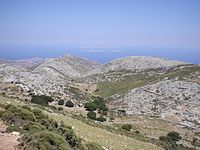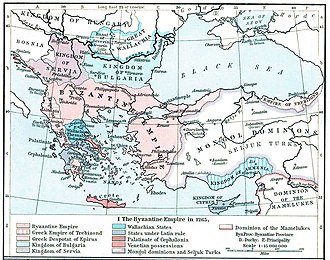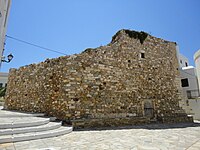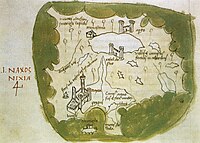Naxos
Native name: Νάξος | ||
|---|---|---|
Region South Aegean | | |
| Regional unit | Naxos | |
| Capital city | Naxos (city) | |
| Demographics | ||
| Demonym | Naxiot | |
| Population | 18,904 (2011) | |
| Pop. density | 44/km2 (114/sq mi) | |
Naxos (
The largest town and capital of the island is Chora or Naxos City, with 7,374 inhabitants (2011 census). The main villages are Filoti, Apiranthos, Vivlos, Agios Arsenios, Koronos and Glynado.
History
Mythic Naxos


According to Greek mythology, the young Zeus was raised in a cave on Mt. Zas ("Zas" meaning "Zeus"). Homer mentions "Dia"; literally the sacred island "of the Goddess". Károly Kerényi explains:
This name, Dia, which means 'heavenly' or 'divine', was applied to several small craggy islands in our [Aegean] sea, all of them lying close to larger islands, such as Crete or Naxos. The name "Dia" was even transferred to the island of Naxos itself, since it was more widely supposed than any other to have been the nuptial isle of Dionysus.[2]
One legend has it that in the Heroic Age before the Trojan War, Theseus abandoned Ariadne on this island after she helped him kill the Minotaur and escape from the Labyrinth. Dionysus (god of wine, festivities, and the primal energy of life) who was the protector of the island, met Ariadne and fell in love with her. But eventually Ariadne, unable to bear her separation from Theseus, either killed herself (according to the Athenians), or ascended to heaven (as the older versions had it). The Naxos portion of the Ariadne myth is also told in the Richard Strauss opera Ariadne auf Naxos.
The giant brothers Otus and Ephialtes figure in at least two Naxos myths: in one, Artemis bought the abandonment of a siege they laid against the gods, by offering to live on Naxos as Otus's lover; in another, the brothers had actually settled Naxos.
It is also said that the sea god

Middle Paleolithic era
Stelida quarry, south-west of
Cycladic civilisation
Zas Cave, inhabited during the Neolithic era, contained objects of stone from Melos and copper objects including a dagger and gold sheet. The presence of gold and other objects within the cave indicated to researchers the status of the inhabitant.[5]
Classical era and Greco-Persian Wars

During the 8th and 7th centuries BC, Naxos dominated commerce in the Cyclades.
Herodotus describes Naxos circa 500 BC as the most prosperous Greek island.[7]
In 499 BC, an unsuccessful attack on Naxos by Persian forces led several prominent men in the Greek cities of Ionia to rebel against the Persian Empire in the Ionian Revolt, and then to the Persian War between Greece and Persia.
Naxos was the first Greek city-state to attempt to leave the Delian League circa 469 BC; Athens quickly quashed the notion and forcibly removed all military naval vessels from the island's control. Athens then demanded all future payments from Naxos in the form of gold rather than military aid.
Byzantine era

In
Under the Byzantine Empire, Naxos was part of the thema of the Aegean Sea, which was established in the mid-9th century.
In Byzantine times, the island's capital was on the southern fortress of Apalyres.
In the late 12th century, it may have been the capital of a short-lived thema of the "Dodekanesos".[8]
Duchy of Naxos



In the aftermath of the Fourth Crusade, with a Latin Empire under the influence of the Venetians established at Constantinople, the Venetian Marco Sanudo conquered Naxos and most of the other Cyclades in 1205–1207.[8] Of all the islands, only on Naxos was there any opposition to Sanudo: a group of Genoese pirates had occupied the castle between the end of Byzantine rule and Sanudo's arrival. To steel his band's resolve, Sanudo burnt his galleys "and bade his companions to conquer or die". The pirates surrendered the castle after a five weeks' siege.[12]
Naxos became the seat of Sanudo's realm, known as the "Duchy of Naxos" or "Duchy of the Archipelago".[8] Twenty-one dukes in two dynasties ruled the Archipelago, until 1566; Venetian rule continued in scattered islands of the Aegean until 1714. Under Venetian rule, the island was called by its Italian name, Nasso.
The Sanudi introduced Western feudal law to the island, based on the Assizes of Romania. However, the native Greek population continued to use Byzantine law for civil matters at least until the late 16th century.[8]
In the 13th century, following the capture of

The relief was temporary, however, as Turkish raids recommenced later in the century. The island was so depopulated that Cristoforo Buondelmonti in c. 1420 claimed that there were not enough men to wed the Naxiot women.[10] The rising Ottoman Empire first attacked the island in 1416, but the Sultans recognized Venetian overlordship over the Duchy in successive treaties, in exchange for an annual tribute.[10]
Ottoman era (1566–1821)
The Ottoman administration remained essentially in the hands of the Venetians; the Porte's concern was satisfied by the returns of taxes. Very few Turks ever settled on Naxos, and Turkish influence on the island was insignificant. Under Ottoman rule the island was known in Turkish as Nakşa. Ottoman sovereignty lasted until 1821, when the islands revolted; Naxos finally became part of the Greek state in 1832.[citation needed]
Early Commentators
Early commentators in English on the island include:[13]
Bernard Randolph, in The Present State of the Islands in the Archipelago (1687, Oxford, pp. 20-21).
Jean de Thévenot, in Travels into the Levant (1687, London, pp. 103-105).
Joseph Pitton de Tournefort, in A Voyage Into the Levant (1718, London, pp. 161-176).
Thomas Bankes et al., in A new royal authentic and complete system of universal geography antient and modern... (1787, London, p. 943).
Edward Daniel Clarke, in Travels in Various Countries (1814, vol. 3, section 2, London, pp. 377-400).
William Martin Leake, in Travels in Northern Greece (1835, vol. 3, London, pp. 93-95).
Theodore Bent, in The Cyclades, or Life Among the Insular Greeks (1885, London, pp. 329-371).
Geography
Climate
Naxos experiences both a
[16] Inland areas of the island are much wetter and cooler in winter, owing to their higher elevation.| Climate data for Naxos town (0m) | |||||||||||||
|---|---|---|---|---|---|---|---|---|---|---|---|---|---|
| Month | Jan | Feb | Mar | Apr | May | Jun | Jul | Aug | Sep | Oct | Nov | Dec | Year |
| Record high °C (°F) | 22.2 (72.0) |
22.3 (72.1) |
25.4 (77.7) |
30.5 (86.9) |
33.6 (92.5) |
36.2 (97.2) |
37.4 (99.3) |
34.0 (93.2) |
33.0 (91.4) |
30.8 (87.4) |
28.8 (83.8) |
24.0 (75.2) |
37.4 (99.3) |
| Mean daily maximum °C (°F) | 14.3 (57.7) |
14.4 (57.9) |
15.7 (60.3) |
18.6 (65.5) |
21.9 (71.4) |
25.7 (78.3) |
26.6 (79.9) |
26.2 (79.2) |
24.6 (76.3) |
21.4 (70.5) |
18.6 (65.5) |
15.8 (60.4) |
20.3 (68.5) |
| Daily mean °C (°F) | 12.0 (53.6) |
12.1 (53.8) |
13.3 (55.9) |
16.1 (61.0) |
19.4 (66.9) |
23.2 (73.8) |
24.7 (76.5) |
24.4 (75.9) |
22.6 (72.7) |
19.3 (66.7) |
16.2 (61.2) |
13.7 (56.7) |
18.1 (64.6) |
| Mean daily minimum °C (°F) | 9.3 (48.7) |
9.3 (48.7) |
10.2 (50.4) |
12.5 (54.5) |
15.4 (59.7) |
19.2 (66.6) |
21.7 (71.1) |
21.7 (71.1) |
19.8 (67.6) |
16.6 (61.9) |
13.4 (56.1) |
10.9 (51.6) |
15.0 (59.0) |
| Record low °C (°F) | 0.4 (32.7) |
−1.0 (30.2) |
2.0 (35.6) |
5.1 (41.2) |
7.1 (44.8) |
12.0 (53.6) |
14.8 (58.6) |
13.6 (56.5) |
11.2 (52.2) |
7.2 (45.0) |
4.5 (40.1) |
2.0 (35.6) |
−1.0 (30.2) |
| Average precipitation mm (inches) | 71.3 (2.81) |
58.6 (2.31) |
49.8 (1.96) |
18.4 (0.72) |
9.8 (0.39) |
2.8 (0.11) |
0.6 (0.02) |
2.8 (0.11) |
5.7 (0.22) |
39.3 (1.55) |
47.4 (1.87) |
69.4 (2.73) |
375.9 (14.80) |
| Average precipitation days (≥ 1.0 mm) | 8.4 | 7.7 | 5.7 | 3.1 | 1.4 | 0.5 | 0.1 | 0.1 | 0.6 | 3.0 | 5.0 | 8.6 | 44.2 |
| Average relative humidity (%)
|
72.0 | 71.2 | 72.0 | 69.5 | 70.7 | 67.8 | 68.7 | 70.2 | 71.1 | 73.2 | 73.8 | 73.3 | 71.1 |
| Source: NOAA[17] | |||||||||||||
| Climate data for Apeiranthos village (600m) | |||||||||||||
|---|---|---|---|---|---|---|---|---|---|---|---|---|---|
| Month | Jan | Feb | Mar | Apr | May | Jun | Jul | Aug | Sep | Oct | Nov | Dec | Year |
| Mean daily maximum °C (°F) | 9 (48) |
10.2 (50.4) |
13 (55) |
15.4 (59.7) |
21.9 (71.4) |
25.1 (77.2) |
27.9 (82.2) |
28.7 (83.7) |
24.9 (76.8) |
22.5 (72.5) |
16.1 (61.0) |
12.3 (54.1) |
18.9 (66.0) |
| Mean daily minimum °C (°F) | 4.8 (40.6) |
5.9 (42.6) |
7.8 (46.0) |
9.7 (49.5) |
15 (59) |
18.6 (65.5) |
21.1 (70.0) |
21.8 (71.2) |
18.7 (65.7) |
16.3 (61.3) |
11.7 (53.1) |
8.6 (47.5) |
13.3 (56.0) |
| Average precipitation mm (inches) | 208.3 (8.20) |
137.8 (5.43) |
80.3 (3.16) |
77.4 (3.05) |
4.7 (0.19) |
1.1 (0.04) |
19.4 (0.76) |
0.1 (0.00) |
24.2 (0.95) |
60.9 (2.40) |
91.1 (3.59) |
155.9 (6.14) |
861.2 (33.91) |
| Source: http://penteli.meteo.gr/stations/apiranthos/ (2019 - 2020 averages) | |||||||||||||
Economy


Historical population
| Year | Island population | Change |
|---|---|---|
| 1981 | 14,037 | – |
| 1991 | 14,838 | +801/+5.71% |
| 2001 | 18,188 | +3,350/+22.58% |
| 2011 | 18,904 | +716/+3.93% |
Tourism
Naxos is a popular
Agriculture
Naxos is the most fertile island of the Cyclades. It has a good supply of water in a region where water is usually inadequate. Mount Zeus (1,004 metres or 3,294 feet) is the highest peak in the Cyclades, and tends to trap the clouds, permitting greater rainfall. This has made agriculture an important economic sector with various vegetable and fruit crops as well as cattle breeding, making Naxos the most self-sufficient island in the Cyclades. Naxos is well known within Greece for its "Arseniko Naxou" cheese, potatoes, Kitron (a local lemon-citrus spirit), and Naxian honey (which is largely derived from the nectar of thyme).[18]
Marble
The quarrying of marble on Naxos began before 550
Sports
Notable people
- Ecumenical Patriarch Anthimus III of Constantinople (1762-1842)
- Ecumenical Patriarch Callinicus III of Constantinople(died 1726)
- Keti Chomata (1946–2010), singer
- Manolis Glezos (1922–2020), rebel, politician, writer
- Giannoulis Fakinos (born 1989), soccer player
- Iakovos Kambanelis(1922–2011), poet, playwright, lyricist and novelist
- Kostas Manolas (born 1991), soccer player
- Stelios Manolas (born 1961), soccer player
- Nikolaos Mykonios, fighter of the Greek War of Independence and officer of the Greek Army
- cantor
- Nicodemus the Hagiorite (1749–1809), saint
- Giorgos Ninios (born 1959), actor
- AEK Athens BC
- Petros Protopapadakis (1854–1922), Prime Minister of Greece
Gallery
-
View through Portara on the peninsula Palátia towards Chora of Naxos
-
Agios Nikolaos on the Grotta of Naxos Town (Chora)
-
Valley between Potamia and Moni, Naxos. View from road from Apeiranthos to Filoti
-
Sanctuary of Dionysus (Yria)
-
Crispi tower, housing the Byzantine museum
-
Panagia Drosiani church, Moni village
-
The monastery of Faneromeni
-
Chalki, Naxos
-
Agios Isidoros at Atsipapi
-
Kaloxilos, Naxos
-
Vourvouria
-
Presentation of the Lord Catholic church of Naxos
-
Koronos village
-
Panagia Damiotissa, Chalki
-
Filoti village
-
Tower in Filoti
-
Apollonas village
-
Keramoti village
-
Tower in Apeiranthos
-
Hawaii beach, Alykos, Naxos
See also
- Communities of the Cyclades
- Emery (rock), mined on Naxos
- Kitron
- Moutsouna
Citations
- ^ https://www.naxos.gr/emery-mines/?lang=en (viewed 01/07/2023).
- Kerenyi, Karl (1951). The Gods of the Greeks. pp. 271–272.
- ^ "Introducing Stelida". stelida.org. Retrieved 17 October 2019.
- PMID 31663021.
- ISBN 1850758247
- ISBN 0415126592
- ^ Herodotus, 5.28,5.31
- ^ ISBN 0-19-504652-8.
- ^ Andrew Ekonomou. Byzantine Rome and the Greek Popes. Lexington books, 2007
- ^ ISBN 978-90-04-09419-2.
- ^ William R. Shepherd, Historical Atlas, 1911
- OCLC 563022439.
- ^ http://www.ucke.de/christian/naxos/Naxos_Old_Travel_Descriptions.pdf (viewed 01/07/2023).
- ^ "Monthly Bulletins". www.meteo.gr.
- ^ "Latest Conditions in Naxos, Cyclades".
- ^ "Latest Conditions in Mikri Vigla of Naxos".
- ^ "Naxos Climate Normals 1961–1990". National Oceanic and Atmospheric Administration. Retrieved 2 March 2015.
- .
- ^ "Archaic Period". Εθνικό Αρχαιολογικό Μουσείο. Government of Greece. Retrieved 26 October 2021.
Item #10 in slide show
- ^ Aenne Ohnesorg: Inselionische Marmordächer. de Gruyter, Berlin 1993.
- ^ Trianet: Gestein und Bergbau Archived 2016-03-04 at the Wayback Machine.
General and cited references
- Agelarakis, A., "The Naxos Island Archaic Period Necropolis: Archaeological-Anthropology Research Report", Hellenic Antiquities Authority, Archival Report, 2005, Naxos.
- Ernst Curtius, Naxos. Ein Vortrag im wissenschaftlichen Verein zu Berlin 1846 gehalten, neu herausgegeben von Martin Biastoch, Göttingen, 2012.
External links
- Official website (in German, Greek, and English)
- Moving Postcards Naxos
- Municipality of Naxos and Small Cyclades (in Greek)
- Photos from Naxos inclusive Tourist-Infos





















